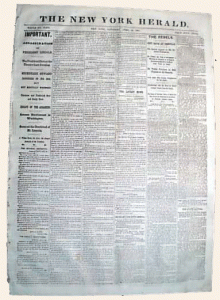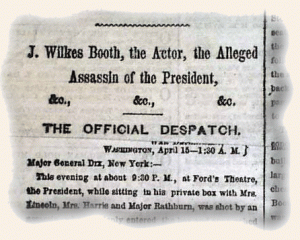April 15, 1865 New York Herald Reprints
September 30, 2008 by GuyHeilenman · 97 Comments
Quick note: If you have an April 15, 1865 New York Herald and it has either an illustration of Lincoln on the front page, or, if it is the “Extra 8:10 AM” edition, it is a reprint. Other reprints exist, but these are the most common. Additional information can be found below and via the Library of Congress’ website.
From our guest contributor, Rick Brown:
I have been collecting Lincoln assassination ephemera for 43 years now. Since I am listed in several directories, I average 2 to 3 telephone calls a month from people wanting to know the value of their old newspapers. In the past 43 years I have been offered the April 15, 1865 New York Herald perhaps as many as 10,000 times and only once was it an original. I’ve heard many a story like “It can’t be a reprint because my great grandfather fought in the Civil War and bought it in New York and brought it back home.” One of the strangest responses I received when I informed the owner their specimen was a reprint was: “Producing a reprint is against the law. Therefore it HAS to be an original!”
To add to the confusion, the first reprint was produced in 1871 and the last about 1908. (This does not include the reprints printed on parchment – those are still being produced today.) Thus, the reprints DO look old because they are old.
In 1995 I did extensive research into newspaper reprints including the April 15, 1865 New York Herald. At that time I documented 32 different versions. The only Herald reprint produced on rag linen was a single sheet printed on both sides. The back page has a large ad for Grain-O-Coffee (who later became the originators of JELLO) and was produced in 1871.
Due to the nation’s centennial in 1876, interest in major events in American history was high. Publishers produced literally a hundred different newspaper reprints of various titles.
Starting in 1890, Kitchel’s Liniment, a patent medicine company, produced an annual version of the April 15, 1865 New York Herald. The front and back page remained the same. Pages 2 and 3 were testimonials for Kitchel’s Liniment. At the top of page 2, centered in the margin, was the phrase “Use Kitchel’s Liniment (1890) and Forever.” Each subsequent annual reprint changed the year in the phrase. The last Kitchel’s Liniment reprint version I have found is 1908. Another patent medicine company that produced New York Herald reprints was MA-LE-NA liver pills. They, too, produced annual reprint versions but with no date indicated like with Kitchel‘s Liniment.
The assassination of President Garfield and McKinley also saw reprints of the April 15, 1865 New York Herald produced. Ford’s Theater and various museum gift shops also sold these reprints and still do today.
While very few actually indicated on the paper itself that is was a reprint, it is important to note that NONE of these reprints were meant to deceive. In the case of the patent medicines, people were hired to give the reprints away at county fairs or other places where a large quantity of people would be gathering. The reprints were a marketing device. It was reasoned that having the Lincoln assassination news on the front and back page, people would not throw them away like they would if it were just a flyer advertising their product.
In the 1930s, however, the height of the American depression, there were a few scam artists who went door to door selling a “valuable relic of American history” – An old April 15, 1865 New York Herald reprint they had obtained in quantity. Unknowing people would take what little cash money they had and purchase it for $1 or so (big money in those days.) They were hoping to sell it for much more. Meanwhile, the scam artist had moved on to another city.
Of the 32 versions I have documented, only one was printed on rag linen; the Grain-O-Coffee one. Four of the versions were single sheet and printed on both sides. All four of these have the date April 15, 1865 on the front page and April 14, 1865 on the back page. Three were printed on parchment paper and the other one on wood pulp paper. The rest of the reprints were 4-page editions. Of the 32 reprint versions, all but 6 of them have printed on the front page in the forth column from the left and about six inches down the phrase EXTRA 8:10 AM is printed. There were NO original 8:10 AM EXTRA editions produced. Originals have eight pages and were printed on rag linen.
One of my continual searches on Ebay is “April 15, 1865 New York Herald.” Currently, on average, there are 3 to 4 of these placed on Ebay on a weekly basis. Very few correctly state that they are offering a reprint. Most claim to be originals. From time to time I will send an email to the seller pointing out that their specimen is actually a reprint and referring them to my site for further information. – http://www.historybuff.com/library/refhotlist.html. Of each ten sellers I send the email to, on average, four thank me for pointing it out to them but seldom edit their listing to point out that it is a reprint; four do not respond at all; and, shamefully, two reply back with something like “You know it is a reprint, and I know it is a reprint, but THEY don’t know it’s a reprint.” In the past 12 years I have used Ebay, only ONCE was an original offered. Fortunately, very few of the April 15, 1865 New York Herald’s reprints actually sell.
Recently, yet another Herald reprint was offered on Ebay that made me snicker. The photo showed one of the single sheet reprints so badly deteriorated that it was in four pieces. The seller stated that he would not normally sell this family heirloom, but for the right price he would sell it. The minimum bid was $100,000!!! I didn’t have the heart to break his bubble.
Rick Brown
HistoryBuff.com
A Nonprofit Organization
Editor’s Note: The Library of Congress also provides a great web page which discusses this commonly reprinted issue: NY Herald Reprints
Typical government job…
September 29, 2008 by TimHughes · Leave a Comment
Much of the intrigue of collecting early newspapers is discovering the many fascinating & bizarre tidbits interspersed amongst the more historic reports for which the newspaper was purchased. They provide a fascinating glimpse into daily life of 100, 200 or 300 years ago, and much like the thrill of those who pan for gold, discovery of these literary golden nuggets can be an absolute delight.
The July 9, 1881 issue of HARPER’S WEEKLY includes two small and inconspicuous notes reading:
“A Western newspaper announces that two desperadoes who were firing pistol-shots at persons passing on the street ‘were ordered to be quiet by Policeman Jones’. “
There is said to be living in Baden an old man who claims the unique title of ‘boot-stretcher to the royal family.’ For many years his sole duty was to wear the new boots of the father of the present Grand Duke until his master could put them on with comfort. The old man now enjoys a pension.”
Have you discovered any fascinating or unusual tidbits in newspapers you have purchased? Please share your story.
Believable?
September 27, 2008 by TimHughes · Leave a Comment
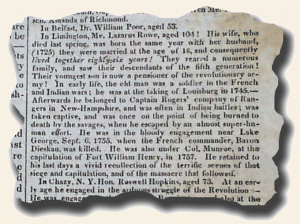 A Columbian Centinel newspaper from Boston, 1829, contains an obituary for a man who was reported to be 104 years old at his death and was married at age 18, and noting his wife had just died earlier in the year. This means they were were married for 86 years. Although this is possible, I often times question the validity of reports in early newspapers. However, a Google search notes that the Guinness Book of World Records records this marriage as the longest on record.
A Columbian Centinel newspaper from Boston, 1829, contains an obituary for a man who was reported to be 104 years old at his death and was married at age 18, and noting his wife had just died earlier in the year. This means they were were married for 86 years. Although this is possible, I often times question the validity of reports in early newspapers. However, a Google search notes that the Guinness Book of World Records records this marriage as the longest on record.
Believe it or not!
Have you ever read an account of something too extraordinary to be believed? Feel free to share with us.
What is the best way to preserve and store newspapers?
September 25, 2008 by TimHughes · 11 Comments
Morris Brill asks several great questions concerning the rare newspaper hobby. I’ll address each over the next several days, beginning with his first:
“What is the best way to preserve and store newspapers?”
I’ve considered several methods through the years. At first I was using large plastic bags and opening the four page papers and slipping them within, then taping & cutting the bag to the size of the newspaper. This way all pages could be read while being protected by the plastic. But this obviously didn’t work if the newspaper had more than four pages.
I’ve considered encapsulation but it is relatively expensive and doesn’t provide the tactile experience so important in this hobby: one needs to touch & feel the paper to better “experience its history”.
After a few other failed experiments at proper storage I decided to customize a product I saw for storage of maps and documents. Since appropriate sizes for newspapers were not available we started making them 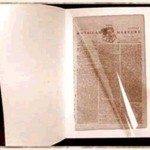 in-house using archival material, now available on our website in eight sizes. These folders also allows the collection to label and make comment on the front of the folder. The newspapers slip in and out of the folders very easily to allow examination of all pages and that important “tactile experience”. I believe University Products offers a similar product but the sizes are not necessarily proportioned for newspapers.
in-house using archival material, now available on our website in eight sizes. These folders also allows the collection to label and make comment on the front of the folder. The newspapers slip in and out of the folders very easily to allow examination of all pages and that important “tactile experience”. I believe University Products offers a similar product but the sizes are not necessarily proportioned for newspapers.
I also like the newspaper storage boxes which University Products offers, and I categorize the newspapers, in folders, by era, one era per box. I find these boxes to be very nice for storing a personal collection and are advertised as being made of archival materials. They are quite strong as well.
If the desire is to show the newspapers to others or for display at a show or convention I might recommend presentation cases which we use for display. We received so much call for this product that we become distributors, now available on our website.
 Best also to keep newspapers our of sunlight and high humidity. Newspapers can be professionally matted & framed quite safely, and UV glass is available if the newspaper will be displayed where the sun will hit it at some point in the day. But I would still avoid contact with the sun as much as possible.
Best also to keep newspapers our of sunlight and high humidity. Newspapers can be professionally matted & framed quite safely, and UV glass is available if the newspaper will be displayed where the sun will hit it at some point in the day. But I would still avoid contact with the sun as much as possible.
More later!
Questions… Questions? Questions!
September 25, 2008 by TimHughes · 23 Comments
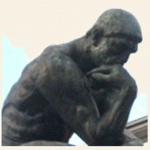 Given that collecting early and rare newspapers is a relatively unknown hobby, there is certainly a wealth of questions which continually come our way by those intrigued by what we offer.
Given that collecting early and rare newspapers is a relatively unknown hobby, there is certainly a wealth of questions which continually come our way by those intrigued by what we offer.
“Don’t the old ones just fall apart?” “Are your issues genuine?” “Do you just sell clippings?” “How big are the headlines?” “Why is the newspaper so white–it can’t be genuine!” “Why are the prices so low?” “Where do you get these newspapers?” “What determines a newspaper’s value?”. etc., etc.
A prime purpose of this blog is to create an atmosphere where we can encourage an on-going discourse about the hobby, and allow everyone to pose questions and topics for discussion, which we will be happy to address in future posts.
Do be in touch with your questions, thoughts, or observations on the hobby. We encourage all to participate and to respond to one another’s thoughts to foster an interesting and meaningful exchange on this fascinating hobby. The easiest way to suggest topics and/or offer questions for future discussion is by responding to this post. Thanks in advance for joining the discussion!
So you collect old newspapers!
September 22, 2008 by TimHughes · 24 Comments
In social situations when asked “What do you do?” I have to be careful how I respond. I’ve learned through experience that stating: “I’m a dealer in rare newspapers” is usually responded to with a pause, then “What?”, followed by a ten minute discussion on just what I do.
Being quick to get the questioner beyond the thought that I’m in the recycling business or that I clip interesting articles upon request, my more detailed response invariably intrigues and fascinates and seldom ends up being a short conversation. There is often a hint of pity in their voice & expression, thinking I have yet to find meaningful employment. But when I mention there are five full-time and several part-time employees, interest in the occupation piques.
If I don’t have the time or interest in a lengthy conversation I’ve at times answered with “I’m an antiques dealer”, which although truthful is also a bit evasive, however it’s also an answer others can understand with limited interrogation.
You, being a collector of rare newspapers, might have had similar experiences when speaking to others about your hobby. Do you have any interesting stories?
So what’s in a name?
September 18, 2008 by TimHughes · 2 Comments
In reading a report from a 1783 Connecticut newspaper this evening I found it interesting to what degree the last name “Arnold” was considered a disgrace. Note this report:
“Upon the memorial of Jonathan Arnold, of Hartford…a Sergeant in the Continental army & unfortunately  bears the sirname of the infamous Benedict Arnold, once a Major General in the army of the United States, now a traitor and deserter…some time after the desertion of the said Benedict, the Hon. Major General Baron Stuben, pitying the misfortune of any person friendly to the American cause doomed to bear the same name with a notorious traitor. offered…liberty to assume the name of Stuben, & by that name to be known and called…on his taking & assuming the said name of Stuben, to pay to him the sum of Two Dollars per month during the present war…”.
bears the sirname of the infamous Benedict Arnold, once a Major General in the army of the United States, now a traitor and deserter…some time after the desertion of the said Benedict, the Hon. Major General Baron Stuben, pitying the misfortune of any person friendly to the American cause doomed to bear the same name with a notorious traitor. offered…liberty to assume the name of Stuben, & by that name to be known and called…on his taking & assuming the said name of Stuben, to pay to him the sum of Two Dollars per month during the present war…”.
I wonder how many more Arnold families there could have been in this country today?
Best of the 20th century?
September 17, 2008 by TimHughes · 9 Comments
As newspaper collectors we dream of “the event” we’d like to add to our collection. It’s the search for that issue–or issues–which make this a fascinating hobby. This is, after all, a very visual hobby. How displayable are stamps and coins? Huge headlines proclaiming a cataclysmic event or magnificent achievement lend themselves so well to display, much more so than an original document about the event.
The 20th century had a great wealth of interesting events. But what is the best? If you could only make one choice, what single headline of the 20th century would you most want to see in your collection?
I wrestle with how to approach this thought: most life-altering? most recognizable? most historic? most appealing for display? I believe the first Wright brothers’ flight is the most life-altering; “Dewey Defeats” Truman” as the most recognizable; and a great “Titanic Sinks” report as the most displayable. Some newspapers did much with the events of the gangster era, and certainly the “careers” of Bonnie & Clyde, John Dillinger and Al Capone are well known and significant reports would be attention-grabbers on any wall. On a more positive note there are some spectacular “V-E Day” and “V-J Day” issues celebrating the end of World War II. But limiting myself to just a single issue I would take “Titanic Sinks”. ….what’s your thought?
Meet the Staff – Timothy J. Hughes – Founder
September 17, 2008 by GuyHeilenman · 17 Comments
Much can be read and said about Tim Hughes, the collector:
- He began collecting coins as a child and quickly became disgruntled with the exuberant prices, which led him to search for an unexploited but interesting collectible. It was this search which helped launch his interest in and love for rare newspapers.
“I wanted to find a hobby that dealt with old things that hadn’t been exploited, that people really didn’t know much about. My thinking was that if it was a hobby that hadn’t been exploited, the prices would be fairly right.”
- He began Timothy Hughes Rare & Early Newspapers in 1976, working part-time from his home. By 1989, the business had grown such that he left his job with Little League Baseball to devote his efforts full-time to the collecting and selling of historic newspapers.
“Whatever money I made selling newspapers, I bought more. It just started snowballing. Eventually I needed to find another location and was able to secure the site of my father’s former saw-sharpening business. It brings me great pleasure to have built the business on the same spot which solicits fond memories of my childhood. My father, who contributes to the business on a part-time basis, still has the opportunity to see the reward of his labor.”
- During the next 20 years the business continued to grow – staff were added, warehouses were annexed to the existing facility, the private collection grew, and rare newspaper friends were made. Eventually Tim decided to sell a majority interest in the company to a group of investors from Lancaster, Pennsylvania. Guy Heilenman was brought in as a part-owner and president, and received 9 months of intensive training from Tim. Although Tim’s intention was to retire, his love for the hobby proved to be too great. As a result, Tim continues to retain part ownership and works as a full-time consultant and part-time contributor to the daily activities of the business. His input is invaluable.
“I’ve always loved this. It’s something that I started from scratch on my own and because I loved it, it’s just been fun. I’ve been very fortunate. I consider myself one of the few people who really loves their work.”
But what about Tim Hughes, the person? He is a family man who dearly loves his wife (Chris) and son (Ben). He is a man of faith who pours himself regularly into the lives of the young people at his church. He continually looks for ways to give back to the community as evidenced by his current and past board appointments to Little League Baseball and North Central Sight Services (a non-profit association helping to meet the needs of the visually impaired). He is also a man of integrity and a loyal friend. Although his knowledge of the hobby is recognized around the world, his humility and love for the collectible continues to fuel ways to enhance the rare newspaper community.
His expertise, sincerity, loyalty and love of the hobby will all be reflected in his blog post contributions. We are both honored and privileged to have him.
Welcome to the History’s Newsstand Blog!
September 17, 2008 by GuyHeilenman · Leave a Comment
 Welcome to the History’s Newsstand Blog published by Timothy Hughes Rare & Early Newspapers. The heart behind the blog is to provide an environment where the love and knowledge of the hobby will be advanced. Over the years many of our fellow collectors have requested such a forum where they can both present their thoughts regarding the collectible and solicit advice from Tim, all with an intention of increasing the awareness of this wonderful, yet relatively unknown collectible. Our hope is that through ongoing discussion focused on early newspapers, novices and experienced collectors alike will benefit from the dialog. We are honored and excited about the opportunity to help guide such discourse.
Welcome to the History’s Newsstand Blog published by Timothy Hughes Rare & Early Newspapers. The heart behind the blog is to provide an environment where the love and knowledge of the hobby will be advanced. Over the years many of our fellow collectors have requested such a forum where they can both present their thoughts regarding the collectible and solicit advice from Tim, all with an intention of increasing the awareness of this wonderful, yet relatively unknown collectible. Our hope is that through ongoing discussion focused on early newspapers, novices and experienced collectors alike will benefit from the dialog. We are honored and excited about the opportunity to help guide such discourse.
Future posts will cover topics related to noteworthy headlines, contemporary reporting of major historic events, the pricing & valuation of old newspapers, preservation & storage, what makes collecting rare newspapers different (and we believe more interesting) than other collectibles (finding golden nuggets, viewing history intimately through the eyes of those whom were there, etc.), the impact of historic newspapers on revisionist history, how to build a collection, and much more. There will also be an opportunity for our collector friends to share their experiences. It is a journey we will take together. Hopefully we will have fun, grow in knowledge, and develop a sense of community.
We welcome and encourage relevant comments and discussion, but fully expect participants to be respectful and considerate of the authors and our business. Since our core values are firmly planted upon the solid foundation of the Judeo-Christian ethic, we ask that all discussion be family friendly. We reserve the right to moderate, delete or edit comments that are vulgar, disrespectful, spam, clearly off topic, or that promote other services and products. Thank you for your understanding.
Don’t forget to bookmark this blog and/or subscribe to the RSS feed [feed | explanation | video]. If RSS is new to you and you’d rather avoid learning about it, we also offer email subscriptions (see the form in the left sidebar). Sign up and have our newest blog posts delivered directly to your inbox!
Welcome again to the launch of the History’s Newsstand’s Blog – a home for those interested in fostering the breadth and depth of the rare newspapers hobby. Spread the word!
Timothy Hughes Rare & Early Newspapers . . .
. . . History’s Newsstand
“…desiring to conduct ourselves honorably in all things.” Hebrews 13:18



